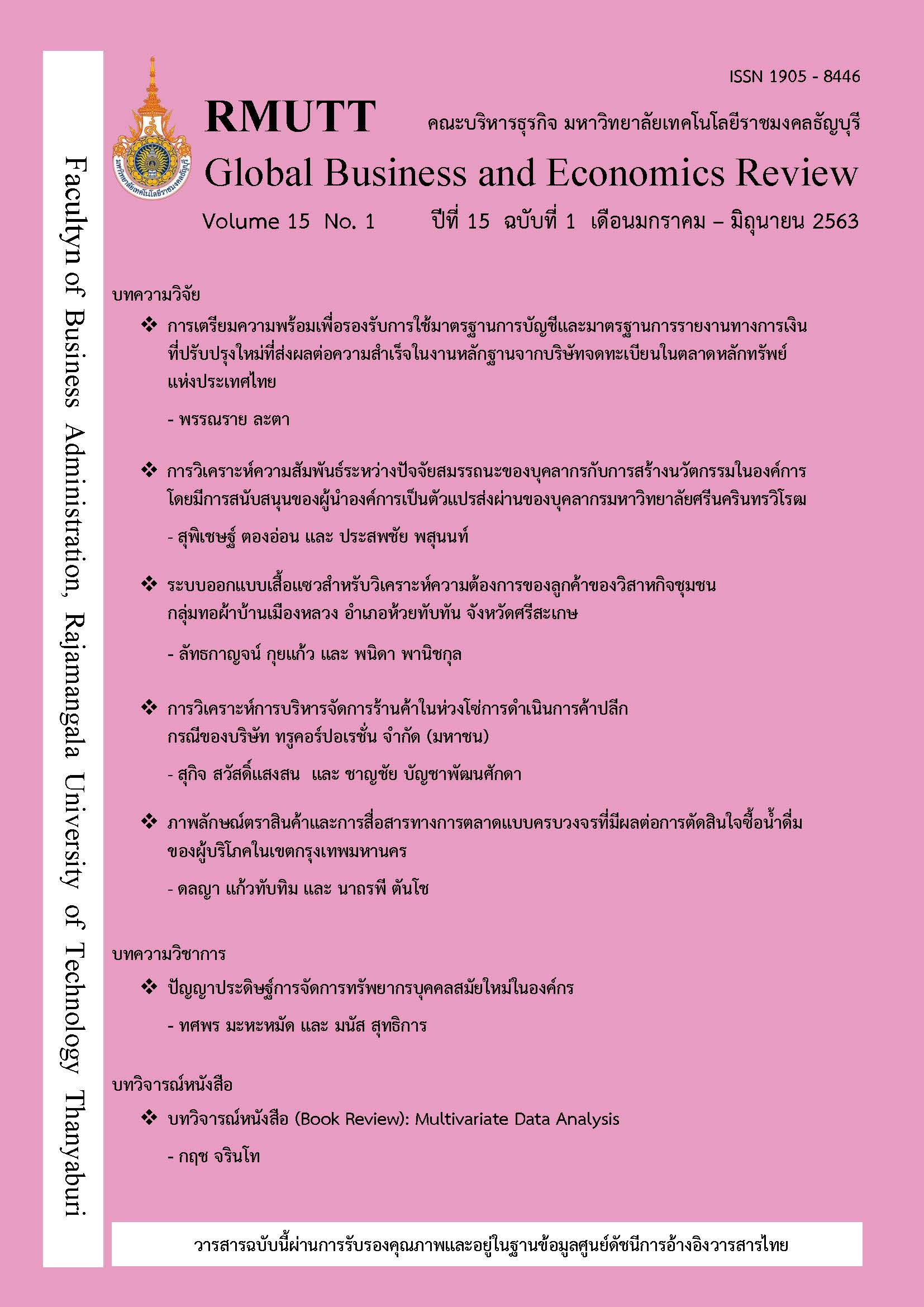The ANALYSIS RELATIONSHIPS BETWEEN COMPETENCY FACTORS AND INNOVATION ORGANIZATION TO ORGANIZATION SUPPORT MEDIATOR OF UNIVERSITY EMPLOYEES OF SRINAKHARINWIROT UNIVERSITY
Keywords:
Innovation Organization, Competency, Organization SupportAbstract
This study aimed to investigate the direct and indirect effects of competency and organization support toward positive innovation organization. The subjects of this study were 303 university employees of Srinakharinwirot University personnel, which were obtained from the data analysis technique of Hair et. al. The studied variables consist of 3 variables which are the competency of the personnel. Support of organizational leaders and creating innovation in the organization. The instrument used in the research was a questionnaire to analyze data by analyzing basic statistical values. And analyzing the causal model Which the research found that the model is consistent with empirical data. With chi-square ( ) equal to 48.163, p-value is 0.55, free degree (df) is 34
/df = 1.417, model consistency index (GFI) is 0.976, square root of the average of the remaining squares error of the estimation (RMSEA) equal to 0.037. And the support of organization leaders Resulting in a positive influence on innovation in the organization as for the competency of personnel, it has a direct indirect influence on the creation of innovation in the organization. In which the causal variables explain the variation in innovation Personnel competencies have a positive influence on the support of organizational leaders. The personnel performance variables explain the variance in the support of the organizational leaders.
References
กนกวรรณ ภู่ไหม. (2559). การศึกษาปัจจัยสนับสนุนการสร้างนวัตกรรมองค์กรบริบทธนาคารไทยพาณิชย์. (วิทยานิพนธ์ปริญญามหาบัณฑิต, มหาวิทยาลัยธรรมศาสตร์).
กัลยา วานิชย์บัญชา และ ฐิตา วานิชย์บัญชา. (2557). การใช้ SPSS for Windows ในการวิเคราะห์ข้อมูล (พิมพ์ครั้งที่ 14). กรุงเทพฯ: โรงพิมพ์สามลดา.
เกริกเกียรติ ศรีเสริมโภค. (2546). การพัฒนาความสามารถเชิงสมรรถนะ. กรุงเทพฯ: โรงพิมพ์นาโกต้า. คณะกรรมการจัดทำยุทธศาสตร์ชาติ. (2559). ยุทธศาสตร์ชาติ ระยะ 20 ปี (พ.ศ. 2560 - 2579). กรุงเทพฯ: สำนักเลขาธิการนายกรัฐมนตรี.
ธนกฤต แซ่โค้ว. (2557). ปัจจัยด้านองค์กรที่ส่งผลต่อพฤติกรรมเชิงนวัตกรรมในการปฏิบัติงานเพื่อรองรับเศรษฐกิจอาเซียนของกลุ่มอุตสาหกรรมแปรรูปเนื้อสัตว์ในเขตกรุงเทพมหานครและปริมณฑล. (วิทยานิพนธ์ปริญญามหาบัณฑิต, มหาวิทยาลัยกรุงเทพ).
เบญจลักษณ์ สมเกียรติ. (2544). ความสัมพันธ์ระหว่างปัจจัยส่วนบุคคล การเปลี่ยนแปลง ระหว่างหัวหน้าหอผู้ป่วยกับพยาบาลประจำการการสนับสนุนจากองค์การกับการปฏิบัติงานตามบทบาทของพยาบาลประจาการ โรงพยาบาลรัฐ กรุงเทพมหานคร. (วิทยานิพนธ์ปริญญามหาบัณฑิต, จุฬาลงกรณ์มหาวิทยาลัย).
พัชรกันย์ เมธาอัครเกียรติ และ วิโรจน์ เจษฎาลักษณ์. (2561). อิทธิพลของการรับรู้การสนับสนุนจากองค์การหัวหน้างานและทีมงานที่มีผลต่อประสิทธิภาพการปฏิบัติงานด้านการสร้างนวัตกรรมระดับบุคคลผ่านสมรรถนะหลักของบุคลากร ในสานักงานคณะกรรมการการศึกษาขั้นพื้นฐาน. Veridian E-Journal, 11(2), 886-908.
ภควดี วรโรจน์ศิริกุล และ นิสดารก์ เวชยานนท์. (2560). ปัจจัยโครงสร้างและสมรรถนะของบุคลากรกับประสิทธิผลของการให้บริการสาธารณะของเทศบาลนคร. Veridian E-Journal, 10(3), 1885-1898.
ภาวัฒน์ พันธุ์แพ. (2547). ผู้นำกับองค์การแห่งการเรียนรู้. กรุงเทพฯ: มหาวิทยาลัยหอการค้าไทย.
พยัต วุฒิรงค์. (2557). การจัดการนวัตกรรม: ทรัพยากร องค์การแห่งการเรียนรู้ และนวัตกรรม. กรุงเทพฯ: สำนักพิมพ์แห่งจุฬาลงกรณ์มหาวิทยาลัย.
ยุทธ ไกยวรรณ์. (2556). การวิเคราะห์โมเดลสมการโครงสร้างด้วย AMOS. กรุงเทพฯ: สำนักพิมพ์แห่งจุฬาลงกรณ์มหาวิทยาลัย.
วิวรรธนี วงศาชโย. (2558). อิทธิพลของการรับรู้การสนับสนุนจากหัวหน้างานและการรับรู้การสนับสนุนจากองค์กรที่มีผลต่อความตั้งใจลาออกผ่านความผูกพันต่อองค์กรด้านจิตใจของพนักงานจ้างเทศบาลนครปฐม. (วิทยานิพนธ์ปริญญามหาบัณฑิต, มหาวิทยาลัยศิลปากร)
ศศิประภา ชัยประสิทธิ์. (2553). องค์กรแห่งนวัตกรรม ทางเลือกของผู้ประกอบการยุคใหม่. วารสารนักบริหาร, 30(2), 60-63.
ส่วนทรัพยากรบุคคล มหาวิทยาลัยศรีนครินทรวิโรฒ. (2561). จำนวนบุคลากรมหาวิทยาลัยศรีนครินทรวิโรฒ. สืบค้นจาก http://hr.op.swu.ac.th/
สำนักงานคณะกรรมการข้าราชการพลเรือน. (2548). คู่มือสมรรถนะราชการพลเรือนไทย. กรุงเทพฯ: สำนักงาน ก.พ.
อัจฉรา หล่อตระกูล. (2557). การพัฒนาสมรรถนะพนักงานมหาวิทยาลัยของรัฐ. (วิทยานิพนธ์ปริญญาดุษฎีบัณฑิต, มหาวิทยาลัยมหาจุฬาลงกรณราชวิทยาลัย.)
Eisenberger, R. & Fasolo, P. (1990). Percevied organizational support and employee dillence, commitment, and innovation. Journal of Applied Psychology, 75(2), 51-59.
Hair, J. F., Black, W. C., Babin. B. J., & Anderson, R. E. (2010). Multivariate data analysis: a global perspective (7th ed.). New York: Pearson Prentice Hall.
McClelland, D. C. (1961). The achieving society. New York: D. Van Nostrand Company Inc.
McKeown, M. (2008). The truth about innovation. London: Prentice Hall.
Siriwaiprapan, S. (2004). A working model of employee competence in the Thai workplace: what constitutes employee competence?. Thai Journal of public administration, 2(1), 123-135.
Downloads
Published
How to Cite
Issue
Section
License
The articles published in this journal are the intellectual property of their respective authors.
The views and opinions expressed in each article are solely those of the individual authors and do not reflect the positions of Rajamangala University of Technology Thanyaburi or any of its faculty members. All components and content of each article are the sole responsibility of the respective authors. In the event of any errors, the authors shall bear full responsibility for their own work.








